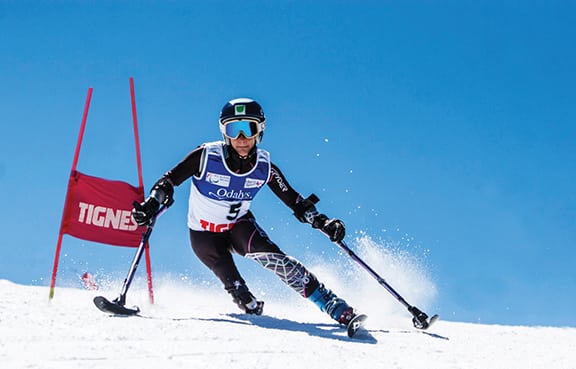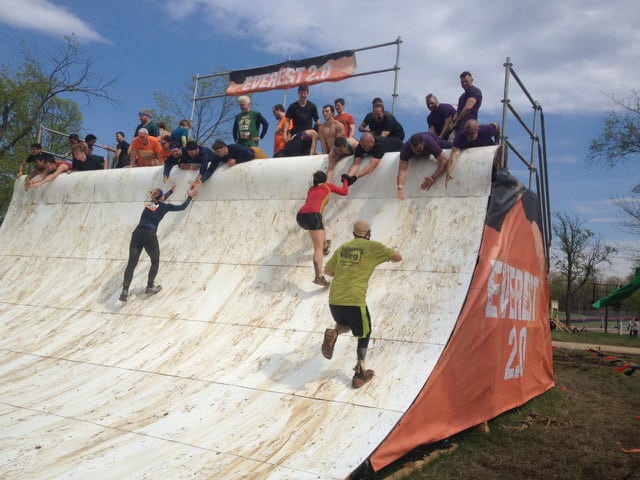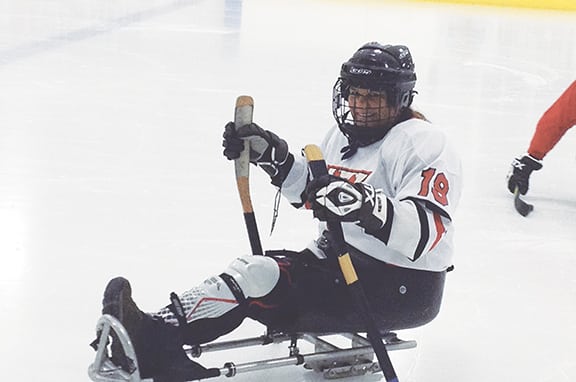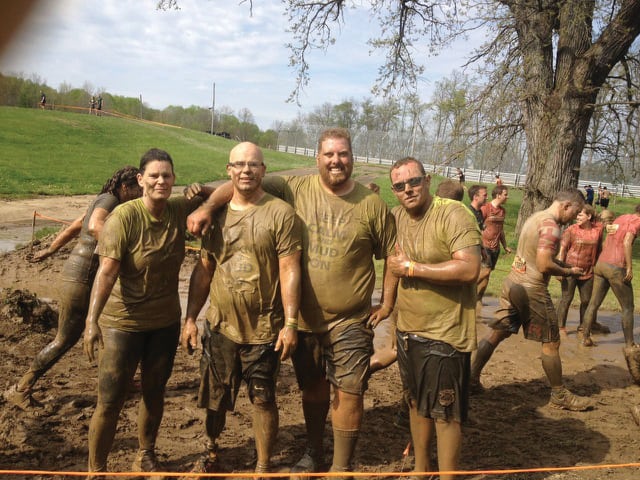The “c” word is not permitted in my home. Nor is it permitted to flash across my television screen during “support” commercials for c + ancer torch victory laps, walks for cures, or pink tool belts. A quick scramble for the remote, and it’s gone.
I never attended a support group. From my perspective, I had two choices—live or die. To live, for me, meant painfully ramming my square peg of a residual limb into that round hole of a prosthesis every morning and getting on with doing things. I didn’t think I needed support; however, I was briefly email-mentored by a military sniper who had his legs blown off in a landmine accident in Afghanistan, and I periodically had coffee meetups with another guy who lost his leg in a motorcycle accident and later set records in the able-bodied division of the Boston Marathon. Though I was unaware of it at the time, these two peers were actually providing the support I so cruelly denied myself.
Looking back now, I realize I filed into my brain every bit of information they offered. Then one day, I was asked to speak at a meeting for local amputees who were in outpatient rehabilitation at the local hospital. With a sudden sense of purpose and healing, I became the leader of my own support group.

An Eye-Opening Experience
After life threw a hard and fast curveball at Steve and Kelley Simon of Denver, the term support group became as common as breakfast. A 20-week ultrasound revealed that their son’s right leg had not developed completely—it ended above the knee.
“Before we found out about Clay’s condition, we had virtually no interaction with anyone with an amputation or limb difference,” explains Steve. “We found out within weeks of moving from San Diego to Denver, so fortunately we were able to meet up with the LIM359 folks in Denver. We attended a social event with [the support group] before Clay was born…. That was our first exposure to others in the amputee community. These are all normal and happy people. It was also our first realization that Clay will be able to live a normal and happy life.”
This realization came through repeated exposure to amputees and the vital interaction between them and members of their support group.
“That first event we went to before he was born was a social event—pizza and beers,” Steve says. “But it was great talking and meeting with folks. I do recall that first event being eye-opening, having never known anyone with limb loss and then being in a room filled with folks that do [have limb loss]. That’s just human nature. It’s why I don’t take any offense whatsoever if someone looks at Clay’s leg. It’s curiosity. Nothing wrong with that. Now though, it’s something I don’t even pay attention to, or really notice actually, when I’m with [the group].”
Now 2, Clay began walking independently on his prosthesis at 20 months. Exposure to other amputees has also helped the couple introduce their 5-year-old daughter to others with differences.
More than just finding peer support, belonging to a group has moved the Simons’ involvement from being supported to also offering it. In addition to attending several social events per year, Steve now serves as treasurer on the group’s board of directors and is working at developing a kid’s camp for younger members of the limb-loss community.
“I love that Clay will have positive role models as he gets older,” Steve says. “Right now, it’s mostly for us, because he’s only 2. But it will be more for him as he gets older. I love that he will have the opportunity to hang out with fun and active people that don’t seem to let a disability affect their happiness or quality of life…. I love that we will have the opportunity to help others who find themselves in a similar situation.”

Gaining Confidence
For Melanie Schwartz, her support group took a different form. Born missing part of her leg, the Canadian-born athlete joined the Ontario Track 3 Ski Association—a disability- geared skiing group—at age 9 and spent the first five years learning how to ski. Advancing to three-track (one ski and two outriggers), Schwartz spent three additional years skiing without her prosthesis before becoming an instructor.
The association began in 1972 simply as Track 3—its logo depicting an amputee skier using two outriggers for balance. Morphing from a handful of amputees using secondhand ski equipment to an organization recognizing the needs of an athletically inclined disability community, Track 3 and its 450 or so volunteers now provide ski and snowboard programs for young amputees and youths with all forms of disability.
“…Track 3 gave me confidence when I was a painfully shy child,” says Schwartz. “…In my preteen and teen years, I went through a phase where I was very self-conscious about my leg. I refused to wear shorts to school. I chose long skirts for fancy events. But throughout that phase, I was able to remove my prosthetic leg and confidently ski without it. I cannot run or skate as fast as an able-bodied person. But I can ski as fast as anyone. Most children run around. My running is clunky, slow, and awkward, so being able to feel the wind on my face while skiing gave me that sense of freedom that other kids get while running. When I started skiing on one leg, people told me that I ‘skied well for having only one leg.’ That was not good enough. I wanted to be a good skier, period. I’m finally achieving that goal.” As a result of her years with the Track 3 group, Schwartz is now a member of the U.S. Paralympics Alpine Ski Team and will be looking for snow this summer when training for 2018 begins.
A Search for Answers Gives Rise to Lasting Support
After her amputation in 2006 due to a serious vehicular accident, Juanita Mengel recognized the need for a support group when she was unable to find the support she needed. The registered nurse and Ohio resident had questions. “How am I going to get through this? What is life going to be like for me now, and will I be able to do many of the same things I did before? I had more questions than answers,” she says.
In spring 2012, Mengel started Amps4ohio in a small community in Ohio. Later moving to Columbus, Ohio, in 2014, the group has thrived and its membership is increasing. With certified peer visitors, activities, and group events, the group is very active, with 30 active members and approximately 40 fringe members. The group gained 12 new members in 2016 and several more in 2017, and projections indicate those numbers will double before the end of the year. Working closely with the orthotics and prosthetics (O&P) community, the group sets up a booth at O&P conferences, health fairs, and veterans’ events.

“If a person can find an activity they like and be around other amputees at a meeting, or can meet one of our certified peer visitors at hospitals, rehabs, [or] homes prior to amputation, I believe it really can help them in the healing process—physically, mentally, and emotionally,” Mengel says. Since founding Amps4ohio, the group’s president has seen her share of support group success stories.
Brian Harvey, from Mansfield, Ohio, credits the group with providing the moral support he needed to heal emotionally following his amputation 12 years ago due to a work-related accident.
“They were [familiar with the issues]. Most of them had been amputees for quite some time,” recalls Harvey. “They had some valuable information. They were only a phone call away. I knew I could call any of them and they would answer. I found purpose again and found [a] reason to move on and go forward and take my life back. I made some pretty awesome friends, too.”
With activities like yoga, adaptive skiing, kayaking, and shooting range days, Amps4ohio covers plenty of ground trying to engage its members. “I feel that I am part of an elite team,” Harvey continues. “A good support group is a good thing, but if you can find a great support group, that is a great thing. They are there to help; that is what they do—lean on each other…. Let them help you help yourself.”

Where Is Everybody?
Attracting new support group members and retaining them can sometimes be a challenge. Here are some tips to help you get started:
Get the word out.
Create flyers and distribute them at your local hospital, doctors’ offices, physiotherapy clinics, grocery stores, laundromats, military organizations—the possibilities for free advertising are endless.
Remember that variety is the spice of life.
Offer activities that appeal to members with all levels of amputation, such as board games, card nights, golf, hiking, and museum outings. Group discounts sometimes apply.
Get freebies.
Procure donations of goods or services and draw names at meetings. Who doesn’t like to win a prize? Free coffee and a donut, a pass to a local gym, a free massage—you get the picture.
Invite volunteer speakers.
Know someone who plays poker and can teach? Know a skin care specialist? Events don’t always have to be specific to amputees.
Use social media.
Create a page for your support group. Post event dates, and blast meeting reminders. Keep the page current—nothing kills interest faster than out-of-date posts.



